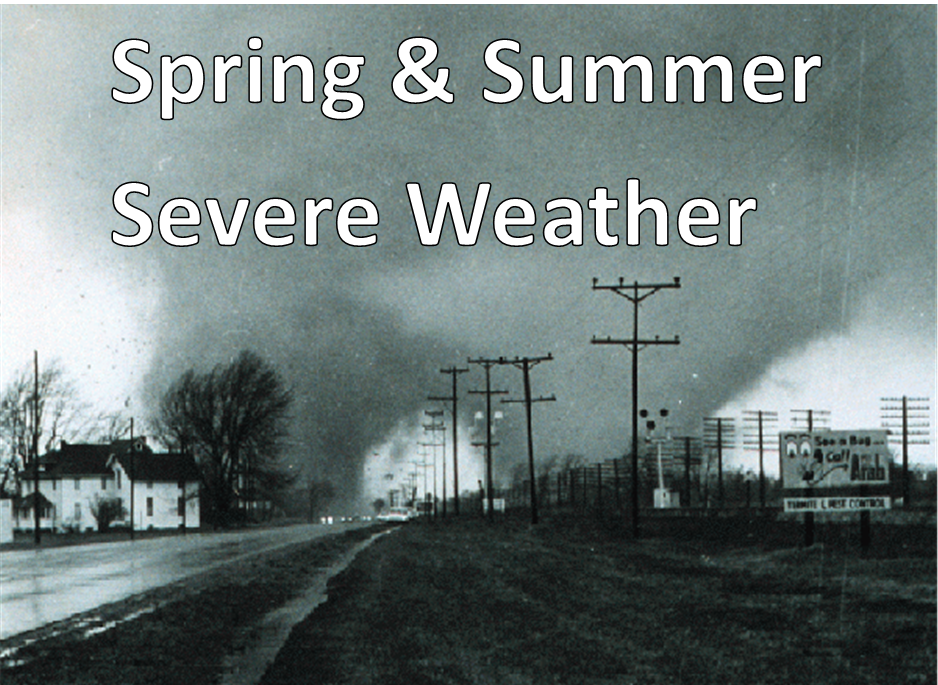Click an image above to access INPREPared's collection of educational resources about Spring and Summer Severe Weather (including tornadoes) or our site dedicated to resources about Tornado Response and Recovery. These sites contain a variety of educational materials for use by Extension, teachers, media, and the general public, including PREPnotes, PREPclip videos, archived news postings, ready-to-use social media, and more.
Summary Highlights about Tornadoes
Tornadoes are nature’s most violent storms. Spawned from powerful thunderstorms, tornadoes can cause fatalities and devastate a neighborhood in seconds.
A tornado appears as a rotating, funnel-shaped cloud that extends from a thunderstorm to the ground with whirling winds that can reach 300 miles per hour. Damage paths can be in excess of one mile wide and 50 miles long. Every state is at some risk from this hazard.
Some tornadoes are clearly visible, while rain or nearby low-hanging clouds obscure others. Occasionally, tornadoes develop so rapidly that little, if any, advance warning is possible.
Before a tornado hits, the wind may die down and the air may become very still. A cloud
of debris can mark the location of a tornado even if a funnel is not visible. Tornadoes
generally occur near the trailing edge of a thunderstorm. It is not uncommon to see
clear, sunlit skies behind a tornado.
Key Terms
- TORNADO WATCH: Tornadoes are possible. Remain alert for approaching storms. Watch the sky and stay tuned to NOAA Weather Radio, commercial radio, or television for information.
- TORNADO WARNING: A tornado has been sighted or indicated by weather radar. Take shelter immediately.
Before a Tornado
To prepare for a tornado, you should:
- Be alert to changing weather conditions
- Listen to NOAA Weather Radio or to commercial radio or television newscasts
for the latest information. - Look for approaching storms.
- Look for the following danger signs:
- Dark, often greenish sky
- Large hail
- A large, dark, low-lying cloud (particularly if rotating) - Loud roar, similar to a freight train. - If you see approaching storms or any of the danger signs, be prepared to take shelter immediately.
During a Tornado
IF YOU ARE IN:
- A structure (residence, small building, commercial building, farm structure)
- A vehicle. trailer, or mobile home
- The outside with no shelter
THEN:
- Go to a pre-designated shelter area such as a safe room, basement, storm cellar, or the lowest building level. If ther is no basement, go to the center of an interior room on the lowest level (closet, interior hallway) away from corners, windows, doors, and outside walls. Put as many waslls as possible between you and the outside. Get under a sturdy table and use your arms to protect your head and neck. Do not open windows.
- Get out immediately and go to the lowest floor of a sturdy, nearby building or a storm shelter. Mobile homes, even if tied down, offer little protection from tornadoes.
- Lie flat in a nearby ditch or depression and cover your head with your hands. Be aware of the potential for flooding.
- Do not get under an overpass or bridge. You are safer in a low, flat location.
- Never try to outrun a tornado in urban or congested areas in a car or truck. Instead, leave the vehicle immediately for safe shelter.
- Watch out for flying debris. Flying debris from tornadoes causes most fatalities and injuries.
Following a Tornado
The following are guidelines for the period following a tornado:
- Safety is a primary issue, as are mental and physical well-being. If assistance is available, knowing how to access it makes the process faster and less stressful. This section offers some general advice on steps to take after disaster strikes in order to begin getting your home, your community, and your life back to normal.
- Check for injuries. Do not attempt to move seriously injured persons unless they are in immediate danger of death or further injury. If you must move an unconscious person, first stabilize the neck and back, then call for help immediately.
- If you are trapped, cover your mouth with a cloth or mask to avoid breathing dust. Try to call, send text message, bang on pipe or wall, whistle, or shout.
- Be aware of exhaustion. Don’t try to do too much at once. Set priorities and pace yourself. Get enough rest.
- Drink plenty of clean water.
- Eat well.
- Wear sturdy work boots and gloves.
- Wash your hands thoroughly with soap and clean water often when working in debris.
Be aware of new safety issues created by the disaster.
- Watch for washed out roads, contaminated buildings, contaminated water, gas leaks, broken glass, damaged electrical wiring, and slippery floors.
- Inform local authorities about health and safety issues, including chemical spills, downed power lines, washed out roads, smoldering insulation, and dead animals.
- Keep a battery-powered radio with you so you can listen for emergency up- dates and news reports.
- Use a battery-powered flash light to inspect a damaged home.
- Use the phone only to report life-threatening emergencies.
- Stay off the streets. If you must go out, watch for fallen objects; downed electrical wires; and weakened walls, bridges, roads, and sidewalks.
- Walk carefully around the outside and check for loose power lines, gas leaks, and structural damage. If you have any doubts about safety, have your residence inspected by a qualified building inspector or structural engineer before entering.
- Do not approach or attempt to help an injured or stranded animal.
- Do not attempt to move a dead animal. Animal carcasses can present serious health risks. Contact your local emergency management office, health department, Extension personnel, or Indiana Board of Animal Health for help and instructions.
Do not enter if:
- You smell gas.
- Structure integrity appears to be severely degraded, or floodwaters remain in or around the building.
- Your home was damaged by fire and the authorities have not declared it safe.
If it is safe to enter, check the following:
- Natural gas or Propane.
- If you smell gas or hear a hissing or blowing sound, open a window and leave immediately. Turn off the main gas valve from the outside, if you can. Call the gas company from a neighbor’s residence. If you shut off the gas supply at the main valve, you will need a professional to turn it back on. Do not smoke or use oil, gas lanterns, candles, or torches for lighting
inside a damaged home until you are sure there is no leaking gas or other flammable materials present.
- If you smell gas or hear a hissing or blowing sound, open a window and leave immediately. Turn off the main gas valve from the outside, if you can. Call the gas company from a neighbor’s residence. If you shut off the gas supply at the main valve, you will need a professional to turn it back on. Do not smoke or use oil, gas lanterns, candles, or torches for lighting
- Sparks, broken or frayed wires.
- Check the electrical system unless you are wet, standing in water, or unsure of your safety. If possible, turn off the electricity at the main fuse box or circuit breaker. If the situation is unsafe, leave the building and call for help. Do not turn on the lights until you are sure they’re safe to use. You may want to have an electrician inspect your wiring.
- Roof, foundation, and chimney cracks.
- If it looks like the building may collapse, leave immediately.
- Appliances.
- If appliances are wet, turn off the electricity at the main fuse box or circuit breaker. Then, unplug appliances and let them dry out. Have appliances checked by a professional before using them again. Also, have the electrical system checked by an electrician before turning the power back
on.
- If appliances are wet, turn off the electricity at the main fuse box or circuit breaker. Then, unplug appliances and let them dry out. Have appliances checked by a professional before using them again. Also, have the electrical system checked by an electrician before turning the power back
- Water and sewage systems.
- If pipes are damaged, turn off the main water valve. Check with local authorities before using any water; the water could be contaminated. Pump out wells and have the water tested by authorities before drinking. Do not flush toilets until you know that sewage lines are intact.
- Food and other supplies.
- Throw out all food and other supplies that you suspect may have become contaminated or come in to contact with floodwater.
- Your basement.
- If your basement has flooded, pump it out gradually (about one third of the water per day) to avoid damage. The walls may collapse and the floor may buckle if the basement is pumped out while the surrounding ground is still waterlogged.
- Open cabinets.
- Be alert for objects that may fall.
- Clean up household chemical spills.
- Disinfect items that may have been contaminated by raw sewage, bacteria, or chemicals. Also, clean salvageable items.
- Call your insurance agent.
- Take pictures of damages. Keep good records of repair and cleaning costs.
Additional Resources
If you need more information contact: inprepared@purdue.edu.
© 2020 Purdue University | An equal access, equal opportunity university | Extension Intranet
615 West State Street, West Lafayette, IN 47907-2053
If you have trouble accessing this page because of a disability, please email us at extension@purdue.edu.




